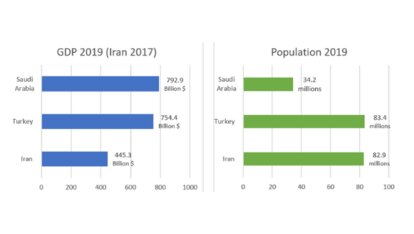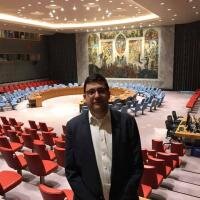MENAPOL Blog
A Changing Regional Dynamic in MENA: From a Bipolar to a Tripolar System

Historically, the Middle East has been the battleground of two mighty powers, forming a competing bipolar political system. Throughout the millennia the names changed and the power centers moved, but it was still two powers. There were a few exceptions when one great power took over the region and held it for a time, like Alexander Macedonian Empire, the Muslims Arab Khalifates, and later the Ottomans Empire. Nevertheless, the bi-polar nature of the region always reasserted itself, and the Pharos in Egypt clashed with the different Mesopotamian Empires, while the Romans and Byzantine fought the Sassanid.
In modern times, the countries that gained their independence following WW2, reassembled themselves in two larger blocs, becoming aligned with the two cold war coalitions. This continued until the Iranian revolution and Egypt’s peace treaty and its quasi isolation shattered the status quo. In the next iteration, the two blocs were regrouped into a pro-western alliance vs the axis of ‘resistance’ alliance.
This paper proposes that a new rearrangement is unfolding, but this time with an added twist of having Turkey as one of the three regional poles, along with the ‘resistance’ axis spearheaded by Iran, with its proxies operating in Iraq, Lebanon, Syria, and Yemen, and the old western alliance headed by the KSA enjoying the support of most of the GCC and Egypt. It is worthy to note that Israel has always been a strong regional power in MENA, but for the obvious reasons it was always apart, isolated, and playing defensive. With the recent flurry of peace and normalization treaties between Israel and several Arab countries, it looks like the pro-western pole will be enlarged to include Israel, a surprising move that could partly be explained by the growing threat of Turkey and lingering menace of Iran.
There is no argument that both Iran and the KSA-Egypt are regional middle powers in MENA. Economically and militarily this is unequivocal, however arguing that Turkey is now operating at that level needs further evidence-based analysis, which this paper will tackle in the next sections:
Economy and Demography
Although, Turkey has been economically reeling recently, with a sharp currency devaluation, it is still the 20th largest world economy, and the second largest in MENA just after the KSA. It is important to note that Turkey is not an oil producing country, as opposed to the KSA, and it still enjoys a strong exports economy (number 27th in the world). Moreover, Turkey is doing much better than many other countries in the unfolding pandemic and economic crunch, especially in MENA, as it has not been affected by the crumbling oil prices, while paradoxically being buffeted by the promise of long-term windfalls of the discovery of large gas fields in the black sea!

Demographically and geographically, Turkey is a large country with almost 84 million population, the second largest in MENA after Egypt. Moreover, Turkey and the city of Istanbul enjoy a much sought-after strategic position, at the confluence of many historical trade and immigration routes.
Military Might
Turkey has a large army and has been working diligently on modernizing it. Recently, the Global Fire Power Index ranked Turkey as number 11th in the world, taking number two in MENA after Egypt at number 9, surpassing both Iran and the KSA. Part of this modernization was the overhaul of its military industry, and Turkey became heavily involved in the F-35, a fifth-generation stealthy strike-fighter aircraft, joint program with the US. However, when it decided to buy S-400 anti-air missile system from Russia, the deal was canceled souring the US Turkish relations.

Nevertheless, Turkey still has a growing national arms industry, covering the basic, and significantly innovating in drone warfare, it moved from the third most arms-importing country in 1999, to the 14th most arms-exporting in 2018. Indeed, the Bayraktar and ANKA drones have proven to be a strong weapon system that has been successfully deployed several times in the region with deadly effects.
Power Projection
Last year, when the Assad regime decided to overtake the rebel held Idlib province, it started a major offensive spearheaded by Hezbollah -the Lebanese militia supported by Iran-. The attack was initially very successful, then Turkey unleashed a massive wave of drones, blanketing the sky and decimating the advancing forces. It was a very innovative and unprecedented large-scale use of drone tactics. The same method was later used in several other theaters (Libya and Caucasus), enshrining Turkey’s ability to project force outside its border with minimal costs and maximum benefits, especially when it is coupled with the use of trained and experienced mercenaries on the ground (mostly Syrian from the old Free Syrian opposition army).
The successful Turkish involvement in Libya is a prime example of its growing stature in MENA. Turkey has been one of the primary supporters of the Government of National Accord against military commander Khalifa Haftar, and he launched an offensive to seize the capital in early 2020, Turkey intervened. In an impressive power projection, it was able to stop the advances of the General on Tripoli, pushing back General Haftar’s forces from the outskirts of the capital to the eastern parts of Libya, despite the backing of Egypt and Russia. The events in Libya are an important indicator because they pitted Turkey’s small forces using their innovative drones blitz tactic against a Russian-Egyptian coalition. In that episode Turkey went against Russia, its frenemy in Syria, and sided with the US. This compartmentalization of alliances, depending on the theater and country, is a staple of major powers realpolitik, that play in the world theater according to their immediate interests.
Moreover, Turkey did not stand idly, in recent weeks it embarked on two additional regional power projections, getting involved in the decade old Armenian Azari conflict. There Turkey, once more used the successful tactics perfected in Syria and Libya, sending hundreds of mercenaries, supported by drone-blitz, achieving solid advances on the ground. Then, Turkey also flexed its maritime muscles, de facto expanding its claimed EEZ by sending its warships and excavation vessels to the East Mediterranean, sharply rising tensions with Greece, the EU, and France.
Soft Power
Turkey also has been using its soft power to grow its influence and prestige in the region, spending an impressive aid budget channeled through two major NGOs IHH and TIKA, numerous schools, hospitals, and cultural centers that have been built throughout the region. Meanwhile, thousands of students have been awarded scholarship to learn Turkish and then study in Turkish universities. Additionally, Turkey has been very active on the Islamic scene with the help of Qatar and its ties to the Muslim brotherhood, building mosques and bankrolling clerics. It is a patient, premediated, and well-organized effort, intent on increasing the stature and prestige of Turkey and its president, in the region!
Conclusion
Following this analysis, it is clear that Turkey is now one of the three regional poles in the MENA region. But the question remains: can Turkey sustain such an economically and militarily exacting effort of maintaining its new found reginal power status, expanding it and challenging both Iran and KSA-Egypt for dominance. Or will it crumble and once again fall into a more inward-looking stance, akin to its early 2000 zero-problem regional strategy! Knowing that at this early stage of expansion any missteps can be fatal. While, any over step can also bring the attention of the major powers of US, Russia, China, and to an extent the EU, and lead to painful sanctions, similar to those hammered on Iran.
Finally, tripolar systems are inherently unstable. Historical precedencies have shown that either one poles weakens and the system moves into a much more stable bipolar structure; or the system is further divided becoming a multi polar one. It is a fascinating development, with a lot of moving parts and changing circumstances, but it is safe to say that in MENA what was a bipolar regional competition between Iran and KSA-GCC has now become a tripolar rivalry!
About the author

